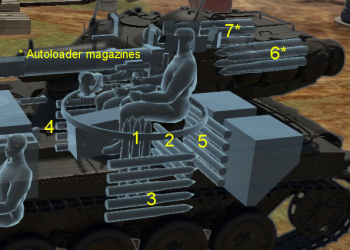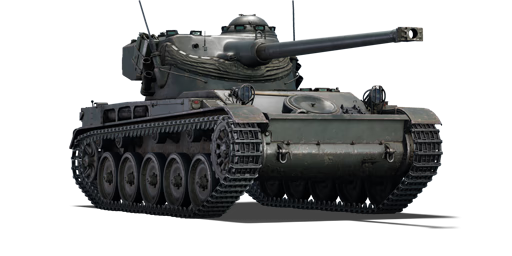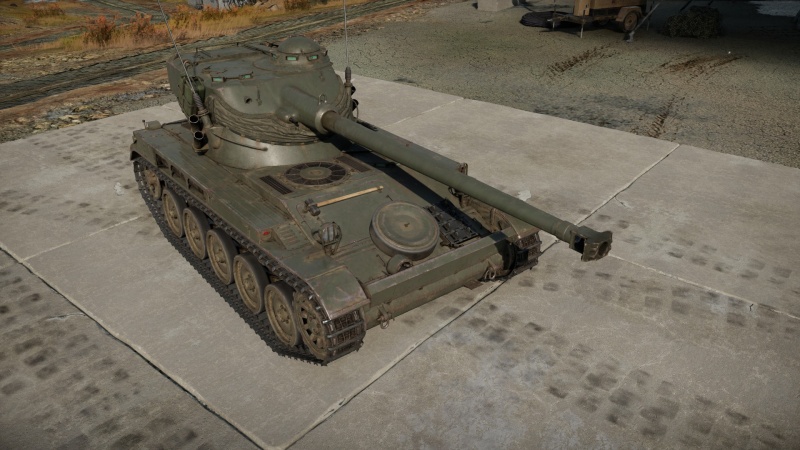AMX-13
| This page is about the French light tank AMX-13. For other versions, see AMX-13 (Family). |
Contents
Description
The AMX-13 is a rank IV French light tank with a battle rating of 6.3 (AB) and 6.7 (RB/SB). It was introduced in Update 1.75 "La Résistance". The AMX-13's chassis is the mainstay of France's light tank technology for the post-war period and this one is its most iconic iteration as it is mounted with the FL10 turret. This vehicle is one of the best light tanks at its battle rating, capable of fulfilling many roles on the battlefield.
The AMX-13 series has one of the most distinctive looks of all armoured warfare's history as it combines many unusual design choices. First, this tank does not feature a "classical" layout: engine deck is next to the driver and the turret ring is at the rear of the tank's hull. Speaking of turrets, this tank has an oscillating one, which means that both gun and turret armour are welded together and that the whole assembly has to rotate to elevate the gun. This way of mounting allows the placement of an autoloader mechanism in the long turret bulge. As for its size, it is very small.
General info
Survivability and armour
Even though this tank has unimpressive armour values, its sloped profile will protect it from autocannon fire (with some distance, even the Bofors can't go through this tank). Any dedicated antitank gun/missile/contraption will go right through this tank's armour. While this may sound a bit bad "getting easily pierced" also has its advantages: some APHE rounds will not detonate upon impact, which will minimise the damage done. If you happen to get shot at, the best way to survive is by showing your right front corner towards the enemy, this way, the engine deck may catch some shells. Don't ever rely on this tank's armour, take every shot you survive as a second chance.
Armour type:
- Rolled homogeneous armour (hull, turret roof, side and rear)
- Cast homogeneous armour (turret base, turret front, gun mantlet, cupola)
| Armour | Front (Slope angle) | Sides | Rear | Roof |
|---|---|---|---|---|
| Hull | 40 mm (38-40°) Turret base 20 mm (66°) Upper glacis 40 mm (cylindrical) Transmission carter 20 mm (51°) Lower glacis |
20 mm (14°) Turret base 20 mm Sides |
20 mm (32-34°) Turret base 15 mm (1°) Top 15 mm (44°) Bottom |
20 mm (24°) Front glacis 10 mm Centre 10 mm (5°) Rear 5 mm Vents |
| Turret | 40 mm (32-47°) Turret front 60 mm (conical) Gun mantlet 40 mm (15-75°) Barrel shroud |
20 mm (0-30°) Turret | 20 mm Turret bustle 20 mm (17-22°) Pivot ball 10 mm (77-90°) Turret underside |
10 mm |
| Cupola | 20 mm (conical) Base 10 mm (spherical) Dome |
20 mm (conical) Outer ring 10 mm (spherical) Centre | ||
Notes:
- Suspension wheels and tracks are 15 mm thick.
- Belly armour is 10 mm thick.
- Storage boxes and mudguards are 4 mm thick.
Mobility
| Game Mode | Max Speed (km/h) | Weight (tons) | Engine power (horsepower) | Power-to-weight ratio (hp/ton) | |||
|---|---|---|---|---|---|---|---|
| Forward | Reverse | Stock | Upgraded | Stock | Upgraded | ||
| Arcade | 68 | 8 | 14.5 | 418 | 515 | 28.83 | 35.52 |
| Realistic | 61 | 7 | 239 | 270 | 16.48 | 18.62 | |
The AMX-13 can carry you wherever you want as its engine allows for fast accelerations and good, sustained, top speed. You will get quickly to a firing position on the battlefield and relocate easily to a new one once spotted.
Modifications and economy
Armaments
Main armament
Well-positioned, this gun can make your enemies cry: with the quick-firing rate it is "one-two, goodbye" for any foe caught from the sides/rear. In usual one-on-one engagements, foes usually exchange shots but, with the AMX-13, this is a lie: it can fire twice before its foe can reload, this can hurt very much. This high rate of fire makes it very efficient at long-distance sniping: it can adjust fire faster than its foes.
High gun placement and good gun depression angles make this tank very efficient at keeping low behind hills while showing very little of itself. Said shortly, this tank's armament is amazing.
| 75 mm SA50 L/57 | Turret rotation speed (°/s) | Reloading rate (seconds) | |||||||||||
|---|---|---|---|---|---|---|---|---|---|---|---|---|---|
| Mode | Capacity | Vertical | Horizontal | Stabilizer | Stock | Upgraded | Full | Expert | Aced | Stock | Full | Expert | Aced |
| Arcade | 36 | -6°/+13° | ±180° | N/A | 28.6 | 39.5 | 48.0 | 53.1 | 56.5 | 5.00 | 5.00 | 5.00 | 5.00 |
| Realistic | 17.9 | 21.0 | 25.5 | 28.2 | 30.0 | ||||||||
Ammunition
| Penetration statistics | |||||||
|---|---|---|---|---|---|---|---|
| Ammunition | Type of warhead |
Penetration @ 0° Angle of Attack (mm) | |||||
| 10 m | 100 m | 500 m | 1,000 m | 1,500 m | 2,000 m | ||
| POT-51A | APBC | 182 | 178 | 162 | 143 | 127 | 113 |
| OE Mle 1951 | HE | 15 | 15 | 13 | 12 | 11 | 10 |
| PCOT-51P | APCBC | 202 | 198 | 180 | 159 | 141 | 125 |
| Shell details | ||||||||||||
|---|---|---|---|---|---|---|---|---|---|---|---|---|
| Ammunition | Type of warhead |
Velocity (m/s) |
Projectile mass (kg) |
Fuse delay (m) |
Fuse sensitivity (mm) |
Explosive mass (TNT equivalent) (g) |
Ricochet | |||||
| 0% | 50% | 100% | ||||||||||
| POT-51A | APBC | 1,000 | 6.4 | - | - | - | 47° | 60° | 65° | |||
| OE Mle 1951 | HE | 753 | 6.2 | 0.2 | 0.1 | 675 | 79° | 80° | 81° | |||
| PCOT-51P | APCBC | 1,000 | 6.4 | - | - | - | 48° | 63° | 71° | |||
Ammo racks

| Full ammo |
1st rack empty |
2nd rack empty |
3rd rack empty |
4th rack empty |
5th rack empty |
6th rack empty |
7th rack empty |
Visual discrepancy |
|---|---|---|---|---|---|---|---|---|
| 36 | 32 (+4) | 28 (+8) | 23 (+13) | 18 (+18) | 13 (+23) | 7 (+29) | 1 (+35) | No |
Notes:
- Shells are modeled individually and disappear after having been shot or loaded.
- Racks 6* and 7* (autoloader magazines) are first stage ammo racks. They total 12 shells.
- These racks get filled first when loading up the tank and are also emptied first.
- As the AMX-13 is equipped with an autoloader, manual reloading of the gun is not possible.
- Once the autoloader magazines have been depleted, you can't shoot until the loader has restocked the autoloader with at least 1 shell.
- The restocking time is longer than the normal reload time of the gun (about 15 seconds). Take this into account when playing.
- Simply not firing when the gun is loaded will move ammo from racks 1 to 5 into rack 7* then 6*. Firing will interrupt the restocking of the ready racks.
Machine guns
| 7.5 mm MAC 31 | ||||
|---|---|---|---|---|
| Mount | Capacity (Belt) | Fire rate | Vertical | Horizontal |
| Coaxial | 4,950 (150) | 551 | N/A | N/A |
The small calibre of the MAC 31 machine gun makes it largely ineffective against all armoured vehicles but the ones with an open compartment. It still can be used to ping targets as a rangefinding help or to mow down minor obstacles blocking your line of sight.
Usage in battles
The AMX-13 is a very competitive tank as it can reach tricky positions quite fast on the battlefield. Its low profile allows it to hide behind many obstacles, serving as armour for this light vehicle. Keeping hull-down, behind a hill on the border of the map is the best way to use this tank: frontal engagements are a no-go with such little armour. AMX-13 commanders will be surprised to be able to shoot 1 round every 5 seconds with such accuracy and power at this BR.
- Long range sniper/flanker
- Stay low and scout targets for your team. When spotting a vulnerable enemy, shoot its engine/transmission/driver, don't get back into cover and finish it off 5 seconds later, only then, fade back into the shadows. Do not get out of cover too often as enemies too much aware of your position may destroy you easily. If spotted, stay as far as possible from enemy fire: this tank's small size can avoid a lot of shots since it takes some serious gunnery skills to hit such a fast and small target from a distance (1000+ m).
- Brawler
- Even though this is not recommended usage, this can tank actually be taken in close-quarter combat. In this role, it behaves much like any SPAA in the same context: flanking and surprising its foes from the sides with a hailstorm of bullets. Use smoke launchers in order to secure roads and advance concealed towards unsuspecting foes.
Pros and cons
Pros:
- Low profile
- Engine on the front will often absorb all damage on the front right side
- Very sloped armour on the front with decent thickness
- Frontally resistant to some SPAA fire (Ostwind and M19)
- Has smoke launchers (high arc of fire)
- Can reach its top speed quite fast
- Gun performance is comparable to the British QF 17-pounder's
- Fast turret rotation
- Stock shell is quite good, although the upgraded shell is a strict improvement
- Short reload time thanks to the 12-round autoloader: 1 shot every 5 seconds, comparable to reload times at low ranks
- Has scouting ability
Cons:
- Thin top armour: vulnerable to strafing planes (can be penetrated by .50 cals with ground target belts at typical strafing ranges)
- Thin sides easily penetrated by SPAAs and HMGs
- Only 3 crew members
- Extremely bouncy suspension: bad at stop-and-shoot due to oscillating turret design
- Bad reverse speed for a light tank
- Bug-like antennas are extremely tall and give away your position when hiding
- Gun penetration subpar in up-tiers: relies heavily on flanking manoeuvres
- Restocking the autoloader is very slow once it has been depleted and it limits severely your combat performance
- Lacks defensive armament against aircraft
History
Development
Development of the AMX-13 began in 1946 in response to a requirement by the French Army for a light tank to support paratroopers. It was designed at Atelier de Construction d'Issy-les-Moulineaux (AMX). A long line of prototypes lead to the production model. The first prototype was the AMX-13 2A in 1948, with four road wheels. Next came the 2B with five road wheels and a raised idler wheel, and the 2C with the FL-10 turret and two return rollers. The 2D introduced an arrangement with four return rollers.
Design
The turret held the commander and gunner, and was set to the rear of the vehicle. The hull was very compact and low profile, with the engine on the right side and the driver in the front, left side.
The main feature of the AMX-13 was the FL-10 oscillating turret, armed with a 75 mm gun with an automatic loader system fed by two six-round magazines, for a total of 12 rounds in the autoloading mechanism. The gun could depress 8° and elevate 12°, with 5° per second of elevation speed. The turret could rotate 360° with 30° per second of traverse speed. A TCV 107 laser rangefinder was provided to the gunner. 6 smoke grenade launchers were fitted on the turret, with 6 more grenades stored in the vehicle. One coaxial 7.62 mm machine gun was fitted, with 1,800 rounds in belts of 200. Another 7.62 mm machine gun could be fitted on an anti-aircraft mount with 1,800 rounds.
The gasoline engine produced 250 horsepower, and the manual transmission had five forward and one reverse gear. The suspension was of the torsion bar type. The drive sprockets were in the front, return rollers in the back, and there were five road wheels and four return rollers. The AMX-13 could reach a speed of 60 kph, and it had a range of 400 kilometers.
The protection of the AMX-13, it being a light tank, was not great. It could withstand heavy machine gun and low-calibre autocannon rounds from the front, but the sides could not even withstand heavy machine gun fire. An appliqué armour package was developed to increase protection at the choice of the user.
Production
Production began in 1952, at Atelier de Construction Roanne (ARE). Over 7,000 AMX-13s of all variants were produced, seeing export to a number of nations as well as seeing service with the French Army. Production shifted to Creusot-Loire at Chalon-sur-Saône in 1964, since ARE began producing the AMX-30 in that year.
Service
The French Army received most of the original 75 mm-armed version, with about 3,000 entering service. They were assigned to the regular armoured units, which were mostly filled with M47 and M48 Patton medium tanks at the time. AMX-13 squadrons had four tanks, and were split into two sections of one infantry section and one light tank section each, along with an ammunition truck and command vehicle. These squadrons were used for screening and reconnaissance, locating enemy forces and engaging them. After the first section had engaged the enemy and was reloading, the second section engaged the enemy. The process of alternating reloading and firing between the sections allowed the tanks to hold off the enemy until medium tanks arrived.
In the 1960's, the AMX-30 entered service. AMX-13s were used during the decolonization war in Algeria (1954-1962), although they saw little combat due to the lack of opposition and the terrain. After the French AMX-13s were up-gunned with the 90 mm gun, they often saw service in foreign theatres of operation due to their relative inexpensiveness. The AMX-13s were decommissioned and put into reserve starting in 1985.
Media
- Skins
- Videos
See also
- Vehicles equipped with the same chassis
- Other vehicles of similar configuration and role
External links
| Ateliers de construction d'Issy-les-Moulineaux (AMX) | |
|---|---|
| Light tanks | |
| AMX-13 | AMX-13-M24 · AMX-13 (FL11) · AMX-13 · AMX-13 (SS.11) · AMX-13-90 · AMX-13 (HOT) |
| Armoured cars | AMX-10RC |
| Medium tanks | AMX M4 · AMX-50 (TOA100) |
| MBTs | |
| AMX-30 | AMX-30 · AMX-30 ACRA · AMX-30 (1972) · AMX-30B2 · AMX-30B2 BRENUS · AMX-30 Super |
| AMX-32/40 | AMX-32 (105) · AMX-32 · AMX-40 |
| Heavy tanks | AMX-50 Surbaissé · AMX-50 Surblindé |
| Tank destroyers | ELC bis · AMX-50 Foch |
| SPAAGs | AMX-13 DCA 40 · AMX-30 S DCA |
| Export | AMX-13 |
| France light tanks | |
|---|---|
| AMC.34/35 | AMC.34 YR · AMC.35 (ACG.1) |
| H.35/39 | H.35 · H.39 · H.39 "Cambronne" |
| AMX-13 | AMX-13 (FL11) · AMX-13-M24 · AMX-13 · AMX-13 (SS.11) · AMX-13-90 · AMX-13 (HOT) |
| Wheeled | AML-90 · AMX-10RC · Vextra 105 |
| AMD.35 | AMD.35 · AMD.35 (SA35) |
| E.B.R. | E.B.R. (1951) · E.B.R. (1954) · E.B.R. (1963) |
| Other | FCM.36 · R.35 (SA38) · Char 25t · MARS 15 · VBCI-2 (MCT30) |
| Austria | SK-105A2 |
| Great Britain | ▄Crusader Mk.II |
| Netherlands | CV 9035NL |
| USA | LVT-4/40 · ▄M3A3 Stuart |





